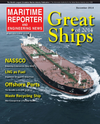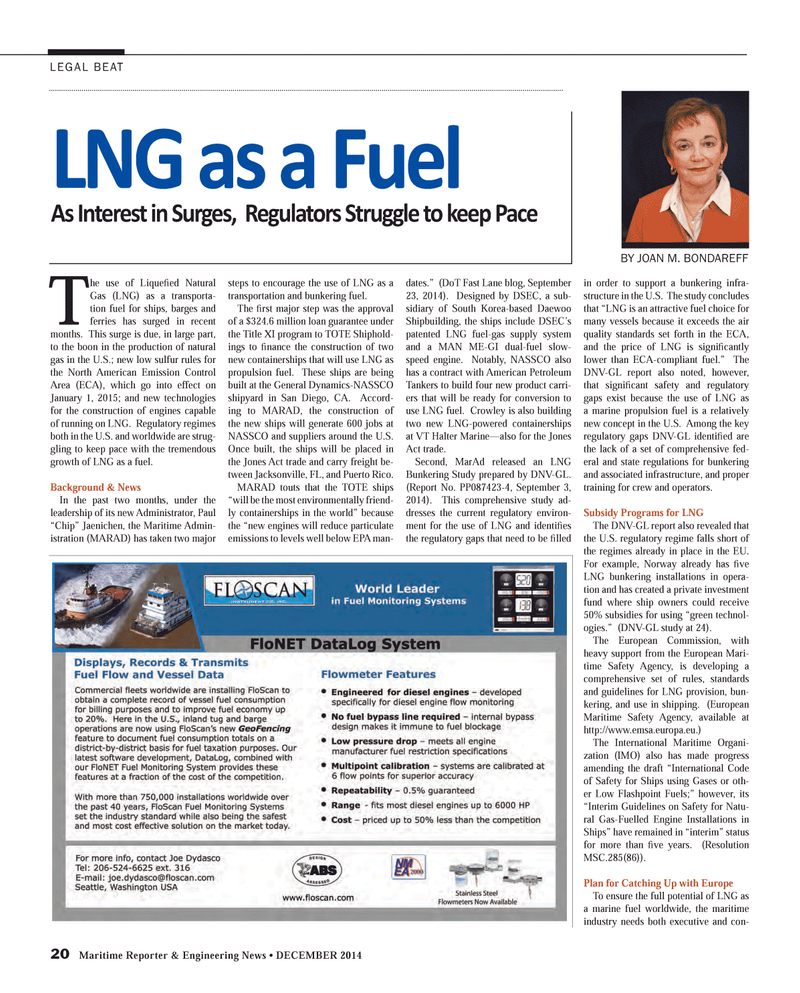
Page 20: of Maritime Reporter Magazine (December 2014)
Great Ships of 2014
Read this page in Pdf, Flash or Html5 edition of December 2014 Maritime Reporter Magazine
20 Maritime Reporter & Engineering News • DECEMBER 2014
LEGAL BEAT
T he use of Liquefi ed Natural
Gas (LNG) as a transporta- tion fuel for ships, barges and ferries has surged in recent months. This surge is due, in large part, to the boon in the production of natural gas in the U.S.; new low sulfur rules for the North American Emission Control
Area (ECA), which go into effect on
January 1, 2015; and new technologies for the construction of engines capable of running on LNG. Regulatory regimes both in the U.S. and worldwide are strug- gling to keep pace with the tremendous growth of LNG as a fuel.
Background & News
In the past two months, under the leadership of its new Administrator, Paul “Chip” Jaenichen, the Maritime Admin- istration (MARAD) has taken two major steps to encourage the use of LNG as a transportation and bunkering fuel.
The fi rst major step was the approval of a $324.6 million loan guarantee under the Title XI program to TOTE Shiphold- ings to fi nance the construction of two new containerships that will use LNG as propulsion fuel. These ships are being built at the General Dynamics-NASSCO shipyard in San Diego, CA. Accord- ing to MARAD, the construction of the new ships will generate 600 jobs at
NASSCO and suppliers around the U.S.
Once built, the ships will be placed in the Jones Act trade and carry freight be- tween Jacksonville, FL, and Puerto Rico.
MARAD touts that the TOTE ships “will be the most environmentally friend- ly containerships in the world” because the “new engines will reduce particulate emissions to levels well below EPA man- dates.” (DoT Fast Lane blog, September 23, 2014). Designed by DSEC, a sub- sidiary of South Korea-based Daewoo
Shipbuilding, the ships include DSEC’s patented LNG fuel-gas supply system and a MAN ME-GI dual-fuel slow- speed engine. Notably, NASSCO also has a contract with American Petroleum
Tankers to build four new product carri- ers that will be ready for conversion to use LNG fuel. Crowley is also building two new LNG-powered containerships at VT Halter Marine—also for the Jones
Act trade.
Second, MarAd released an LNG
Bunkering Study prepared by DNV-GL. (Report No. PP087423-4, September 3, 2014). This comprehensive study ad- dresses the current regulatory environ- ment for the use of LNG and identifi es the regulatory gaps that need to be fi lled in order to support a bunkering infra- structure in the U.S. The study concludes that “LNG is an attractive fuel choice for many vessels because it exceeds the air quality standards set forth in the ECA, and the price of LNG is signifi cantly lower than ECA-compliant fuel.” The
DNV-GL report also noted, however, that signifi cant safety and regulatory gaps exist because the use of LNG as a marine propulsion fuel is a relatively new concept in the U.S. Among the key regulatory gaps DNV-GL identifi ed are the lack of a set of comprehensive fed- eral and state regulations for bunkering and associated infrastructure, and proper training for crew and operators.
Subsidy Programs for LNG
The DNV-GL report also revealed that the U.S. regulatory regime falls short of the regimes already in place in the EU.
For example, Norway already has fi ve
LNG bunkering installations in opera- tion and has created a private investment fund where ship owners could receive 50% subsidies for using “green technol- ogies.” (DNV-GL study at 24).
The European Commission, with heavy support from the European Mari- time Safety Agency, is developing a comprehensive set of rules, standards and guidelines for LNG provision, bun- kering, and use in shipping. (European
Maritime Safety Agency, available at http://www.emsa.europa.eu.)
The International Maritime Organi- zation (IMO) also has made progress amending the draft “International Code of Safety for Ships using Gases or oth- er Low Flashpoint Fuels;” however, its “Interim Guidelines on Safety for Natu- ral Gas-Fuelled Engine Installations in
Ships” have remained in “interim” status for more than fi ve years. (Resolution
MSC.285(86)).
Plan for Catching Up with Europe
To ensure the full potential of LNG as a marine fuel worldwide, the maritime industry needs both executive and con-
LNG as a Fuel
As Interest in Surges, Regulators Struggle to keep Pace
BY JOAN M. BONDAREFF
MR #12 (18-25).indd 20 12/4/2014 10:03:18 AM

 19
19

 21
21
